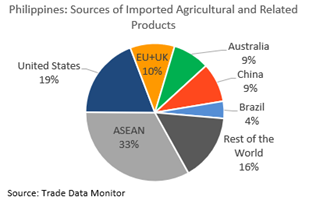Overview
The Philippines is the eighth-largest global market and the top market in Southeast Asia for exports of U.S. agricultural and related products. Already an established and dependable trading partner, the Philippines continues to provide opportunities for exporters because of its young, expanding population and increasing household income. Despite facing logistical and tariff disadvantages, the United States continued to be the largest single-country supplier of agricultural and related products to the Philippines, achieving a record high of $4.1 billion in exports in 2022, indicating a 10-percent increase year-over-year. Long-standing trade relations and strong consumer trust in U.S.-origin products, established over decades, are valuable assets for exporters. Diversification, particularly in consumer-oriented products, is likely to be the path to achieving annual records.
U.S. Exports of Agricultural and Related Products
| Table: Top 10 U.S. Agricultural Exports to the Philippines (Value in Millions of Dollars) | |||||||
| Product | 2018 | 2019 | 2020 | 2021 | 2022 | 2021–2022 % Change | 2018–2022 Average |
| Soybean Meal | 884 | 788 | 899 | 976 | 1014 | 37% | 912 |
| Wheat | 642 | 708 | 814 | 885 | 920 | 51% | 794 |
| Dairy Products | 247 | 273 | 409 | 424 | 582 | 121% | 387 |
| Poultry Meat & Prods. (excl. eggs) | 111 | 102 | 64 | 146 | 221 | -34% | 129 |
| Ethanol (non-beverage) | 125 | 94 | 68 | 48 | 172 | 14% | 101 |
| Beef & Beef Products | 87 | 88 | 62 | 73 | 161 | -11% | 94 |
| Pork & Pork Products | 116 | 93 | 114 | 205 | 135 | 2% | 133 |
| Other Feeds, Meals & Fodders | 73 | 67 | 75 | 84 | 109 | 35% | 82 |
| Processed Vegetables | 102 | 129 | 74 | 95 | 109 | 30% | 102 |
| Food Preparations | 86 | 91 | 109 | 110 | 98 | 12% | 99 |
| Source: U.S. Census Bureau Trade Data - BICO HS-10 | |||||||
In 2022, consumer-oriented products were the largest category of U.S. agricultural and related products exported to the Philippines, amounting to $1.6 billion, signifying a 23-percent increase from 2021. The Philippines has been the top Southeast Asian destination for U.S. consumer-oriented products since 2006. The top products were dairy products ($582 million), poultry products ($221 million, excluding eggs), and beef products ($161 million). The year-over-year growth for U.S. dairy was particularly strong, as exports increased by $156 million. Due to the inability of domestic production to meet demand, the Philippines imports 99 percent of its dairy requirement.
Intermediate products ranked as the second-largest category of U.S. agricultural products exported to the Philippines with a value of $1.4 billion, showing a 17-percent increase from 2021. The top products were soybean meal ($1 billion), ethanol ($172 million, non-beverage), and miscellaneous feeds, meals, and fodders ($109 million). The year-over-year growth for U.S. ethanol was remarkable, with exports increasing by $124 million. The Philippines can only supply 50 percent of demand due to feedstock problem. The remaining 50 percent requirement were mainly sourced from the United States.
Bulk products came in third, accounting for $1 billion worth of U.S. agricultural products exported to the Philippines, representing a three-percent increase from 2021. The top products were wheat ($920 million), soybeans ($60 million), and pulses ($10 million). The Philippines does not cultivate wheat, but wheat flour is an important part of its people’s diet, making the country a major importer of milling wheat. The United States held 79 percent of the market for milling wheat, although other countries supply significant volumes of feed wheat. The Philippines was the largest buyer of U.S. Hard Red Spring (HRS) wheat and Soft White (SW) wheat, and the second-largest buyer of all U.S. wheat classes.
The smallest but fastest growing category among agricultural related products was forest products and seafood, with sales reaching $52 million, up 32 percent year-over-year.
Market Sectors
Food Processing Sector
The food and beverage manufacturing industry expands through broader distribution coverage and the launching of new products. Inflationary pressures from higher raw material costs contribute further growth in sales. Household food and beverage consumption remains strong, and sales are expected to grow six percent in 2023. Some food and beverage processors are offering smaller packaging while price-sensitive consumers shift to lower-cost substitutes or cut back on consumption.
Food Service Sector
Sales of the food service sector is expected to grow by 20 percent as tourism and hotel industry improves. Dining in restaurants, catering, and events will boost sales while food deliveries continue to provide convenience to consumers. Restaurant chains continue to open new stores and franchises.
Food Retail Sector
Food retail sales are expected to grow six percent slower than last year as revenge spending ends. While most consumers have returned to buying from brick-and-mortar stores, food and beverage e-commerce sales continue to grow as a niche market. Retail sales continue accelerating as chains open new outlets while enhancing their imports sections.
Resources
USDA-FAS Manila publishes market and commodity reports available through the Global Agricultural Information Network (GAIN) at https://gain.fas.usda.gov including:
